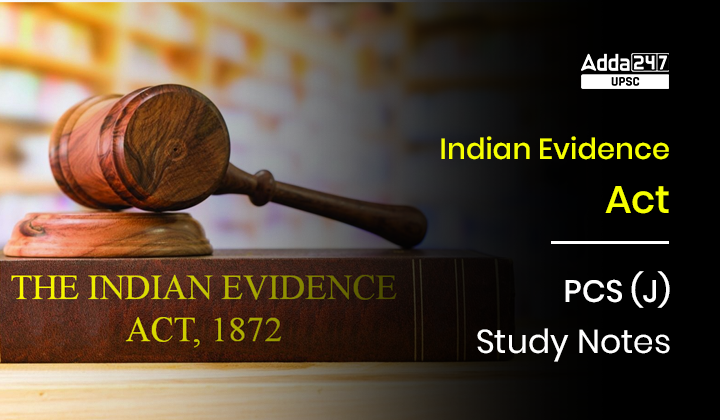Table of Contents
What is Law of Evidence? Know the Applications of Evidence Law
Meaning of Law of Evidence
The term “evidence” refers to anything of value that can be shown to a court of law in order to establish the veracity of any claim or assertion of fact that is the subject of an investigation.
What is Law of Evidence?
Evidence comes from the Latin word “evidere,” which means to verify or demonstrate clearly as proof of anything. Proof, or the quality of providing evidence, is a term that may only be used in reference to the things themselves.
According to Sir Blackstone, “evidence” is anything that “illustrates, clarifies, learns the actuality of contemporary situations, or concentrates on one side of an issue.”
According to Sir Taylor, the Law of Evidence is the means through which the veracity of an argument is established or disproved by court investigators.
Law of Evidence in India
Law of Evidence, however, has a narrower definition and solely applies to the first sense in Indian law. According to the statute, “evidence” refers only to the procedures by which relevant and sufficient facts are presented to the Court and the Court is persuaded of their veracity. Therefore, any confession or statement of any accused person during a trial, in addition to the statements of witnesses and documents supplied for the inspection of the Court.
Definition of evidence in the Indian Evidence Act
Evidence, as defined by Section 3 of the Evidence Act of 1872, is defined as:
- All such statements which the court allows or necessary to be put before it by the witnesses in connection with questions of fact under inquiry. We call these pieces of paper “oral evidence.”
- All relevant documents allowed by the court to examine, including any electronic records. We call these pieces of paper “documentary evidence.”
Function of Law of Evidence
The Law of Evidence is crucial in creating and regulating the proper etiquette and procedure of judicial and quasi-judicial procedures. Therefore, the rules governing the admissibility of evidence are crucial. Court is defined in greater detail in Section 3 of the Indian Evidence Act, which also encompasses the allocation of authorities, judges, magistrates, and anybody with an exception to arbitrariness who is legitimately entitled to accept the evidence.
साक्ष्य का नियम क्या है? साक्ष्य कानून के अनुप्रयोगों को जानें
कानून में साक्ष्य का अर्थ
शब्द “साक्ष्य” किसी भी मूल्य के मूल्य को संदर्भित करता है जिसे किसी भी दावे या तथ्य के दावे की सत्यता स्थापित करने के लिए कानून की अदालत में दिखाया जा सकता है जो एक जांच का विषय है।
साक्ष्य कानून
साक्ष्य लैटिन शब्द “एविडेरे” से आया है, जिसका अर्थ है किसी भी चीज़ के प्रमाण के रूप में स्पष्ट रूप से सत्यापित या प्रदर्शित करना। प्रमाण, या साक्ष्य प्रदान करने की गुणवत्ता, एक ऐसा शब्द है जिसका उपयोग केवल चीजों के संदर्भ में ही किया जा सकता है।
सर ब्लैकस्टोन के अनुसार, “सबूत” कुछ भी है जो “समकालीन स्थितियों की वास्तविकता को दर्शाता है, स्पष्ट करता है, सीखता है, या किसी मुद्दे के एक तरफ ध्यान केंद्रित करता है।”
सर टेलर के अनुसार, साक्ष्य का कानून वह साधन है जिसके माध्यम से अदालत के जांचकर्ताओं द्वारा किसी तर्क की सत्यता को स्थापित या अस्वीकृत किया जाता है।
भारतीय साक्ष्य अधिनियम में साक्ष्य की परिभाषा
1872 के साक्ष्य अधिनियम की धारा 3 द्वारा परिभाषित साक्ष्य को इस प्रकार परिभाषित किया गया है:
- जांच के तहत तथ्य के सवालों के संबंध में ऐसे सभी बयान जिन्हें अदालत गवाहों द्वारा अपने सामने रखने की अनुमति देती है या आवश्यक है। हम कागज के इन टुकड़ों को “मौखिक साक्ष्य” कहते हैं।
- किसी भी इलेक्ट्रॉनिक रिकॉर्ड सहित, अदालत द्वारा जांच के लिए अनुमत सभी प्रासंगिक दस्तावेज़। हम कागज के इन टुकड़ों को “दस्तावेजी साक्ष्य” कहते हैं।
साक्ष्य के कानून का कार्य
न्यायिक और अर्ध-न्यायिक प्रक्रियाओं के उचित शिष्टाचार और प्रक्रिया को बनाने और विनियमित करने में साक्ष्य का कानून महत्वपूर्ण है। इसलिए, साक्ष्य की स्वीकार्यता को नियंत्रित करने वाले नियम महत्वपूर्ण हैं। न्यायालय को भारतीय साक्ष्य अधिनियम की धारा 3 में अधिक विस्तार से परिभाषित किया गया है, जिसमें प्राधिकरणों, न्यायाधीशों, मजिस्ट्रेटों और मनमानेपन के अपवाद वाले किसी भी व्यक्ति के आवंटन को भी शामिल किया गया है जो वैध रूप से साक्ष्य को स्वीकार करने का हकदार है।
FAQs
1. When the Law of Evidence was enforced in India?
Ans: In 1872 the Law of Evidence was enforced in India.
2. According to Sir Taylor, what is Law of Evidence?
Ans: According to Sir Taylor, the Law of Evidence is the means through which the veracity of an argument is established or disproved by court investigators.



 TSPSC Group 1 Question Paper 2024, Downl...
TSPSC Group 1 Question Paper 2024, Downl...
 TSPSC Group 1 Answer key 2024 Out, Downl...
TSPSC Group 1 Answer key 2024 Out, Downl...
 UPSC Prelims 2024 Question Paper, Downlo...
UPSC Prelims 2024 Question Paper, Downlo...





